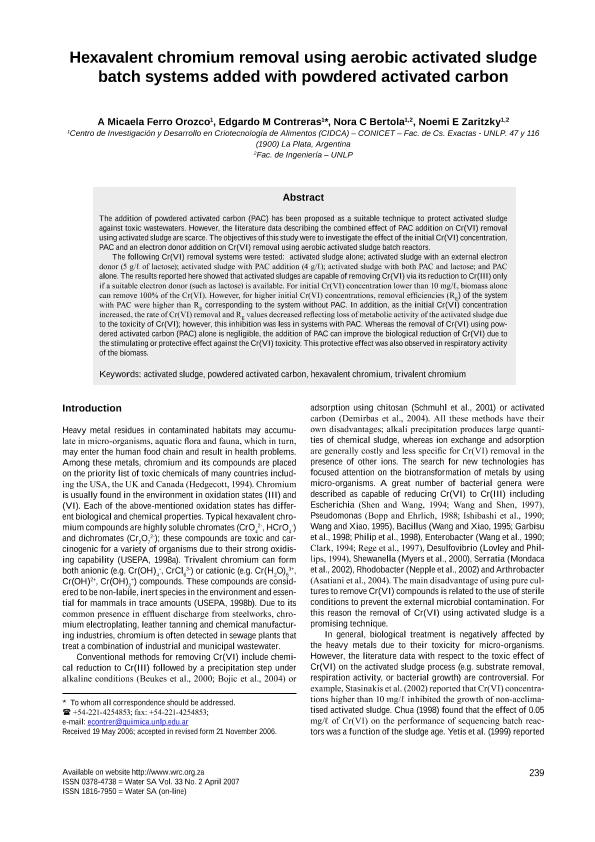Mostrar el registro sencillo del ítem
dc.contributor.author
Ferro Orozco, Ana Micaela

dc.contributor.author
Contreras, Edgardo Martin

dc.contributor.author
Bertola, Nora Cristina

dc.contributor.author
Zaritzky, Noemi Elisabet

dc.date.available
2019-05-10T18:42:48Z
dc.date.issued
2009-12
dc.identifier.citation
Ferro Orozco, Ana Micaela; Contreras, Edgardo Martin; Bertola, Nora Cristina; Zaritzky, Noemi Elisabet; Hexavalent chromium removal using aerobic activated sludge batch systems added with powdered activated carbon; Water Research Commission; Water S.a.; 33; 2; 12-2009; 239-244
dc.identifier.issn
0378-4738
dc.identifier.uri
http://hdl.handle.net/11336/76071
dc.description.abstract
The addition of powdered activated carbon (PAC) has been proposed as a suitable technique to protect activated sludge against toxic wastewaters. However, the literature data describing the combined effect of PAC addition on Cr(VI) removal using activated sludge are scarce. The objectives of this study were to investigate the effect of the initial Cr(VI) concentration, PAC and an electron donor addition on Cr(VI) removal using aerobic activated sludge batch reactors.<br />The following Cr(VI) removal systems were tested: activated sludge alone; activated sludge with an external electron donor (5 g/ℓ of lactose); activated sludge with PAC addition (4 g/ℓ); activated sludge with both PAC and lactose; and PAC alone. The results reported here showed that activated sludges are capable of removing Cr(VI) via its reduction to Cr(III) only<br />if a suitable electron donor (such as lactose) is available. For initial Cr(VI) concentration lower than 10 mg/ℓ, biomass alone can remove 100% of the Cr(VI). However, for higher initial Cr(VI) concentrations, removal efficiencies (RE) of the system with PAC were higher than RE corresponding to the system without PAC. In addition, as the initial Cr(VI) concentration increased, the rate of Cr(VI) removal and RE values decreased reflecting loss of metabolic activity of the activated sludge due to the toxicity of Cr(VI); however, this inhibition was less in systems with PAC. Whereas the removal of Cr(VI) using powdered activated carbon (PAC) alone is negligible, the addition of PAC can improve the biological reduction of Cr(VI) due to the stimulating or protective effect against the Cr(VI) toxicity. This protective effect was also observed in respiratory activity of the biomass.
dc.format
application/pdf
dc.language.iso
eng
dc.publisher
Water Research Commission

dc.rights
info:eu-repo/semantics/openAccess
dc.rights.uri
https://creativecommons.org/licenses/by-nc-sa/2.5/ar/
dc.subject
Activated Sludge
dc.subject
Powdered Activated Carbon
dc.subject
Hexavalent Chromium
dc.subject
Ttrivalent Chromium
dc.subject.classification
Ingeniería Medioambiental y Geológica, Geotécnicas

dc.subject.classification
Ingeniería del Medio Ambiente

dc.subject.classification
INGENIERÍAS Y TECNOLOGÍAS

dc.title
Hexavalent chromium removal using aerobic activated sludge batch systems added with powdered activated carbon
dc.type
info:eu-repo/semantics/article
dc.type
info:ar-repo/semantics/artículo
dc.type
info:eu-repo/semantics/publishedVersion
dc.date.updated
2019-03-15T19:02:23Z
dc.identifier.eissn
1816-7950
dc.journal.volume
33
dc.journal.number
2
dc.journal.pagination
239-244
dc.journal.pais
Sudáfrica

dc.description.fil
Fil: Ferro Orozco, Ana Micaela. Provincia de Buenos Aires. Gobernación. Comisión de Investigaciones Científicas. Centro de Investigación y Desarrollo en Criotecnología de Alimentos. Consejo Nacional de Investigaciones Científicas y Técnicas. Centro Científico Tecnológico Conicet - La Plata. Centro de Investigación y Desarrollo en Criotecnología de Alimentos. Universidad Nacional de la Plata. Facultad de Ciencias Exactas. Centro de Investigación y Desarrollo en Criotecnología de Alimentos; Argentina
dc.description.fil
Fil: Contreras, Edgardo Martin. Provincia de Buenos Aires. Gobernación. Comisión de Investigaciones Científicas. Centro de Investigación y Desarrollo en Criotecnología de Alimentos. Consejo Nacional de Investigaciones Científicas y Técnicas. Centro Científico Tecnológico Conicet - La Plata. Centro de Investigación y Desarrollo en Criotecnología de Alimentos. Universidad Nacional de la Plata. Facultad de Ciencias Exactas. Centro de Investigación y Desarrollo en Criotecnología de Alimentos; Argentina
dc.description.fil
Fil: Bertola, Nora Cristina. Provincia de Buenos Aires. Gobernación. Comisión de Investigaciones Científicas. Centro de Investigación y Desarrollo en Criotecnología de Alimentos. Consejo Nacional de Investigaciones Científicas y Técnicas. Centro Científico Tecnológico Conicet - La Plata. Centro de Investigación y Desarrollo en Criotecnología de Alimentos. Universidad Nacional de la Plata. Facultad de Ciencias Exactas. Centro de Investigación y Desarrollo en Criotecnología de Alimentos; Argentina
dc.description.fil
Fil: Zaritzky, Noemi Elisabet. Provincia de Buenos Aires. Gobernación. Comisión de Investigaciones Científicas. Centro de Investigación y Desarrollo en Criotecnología de Alimentos. Consejo Nacional de Investigaciones Científicas y Técnicas. Centro Científico Tecnológico Conicet - La Plata. Centro de Investigación y Desarrollo en Criotecnología de Alimentos. Universidad Nacional de la Plata. Facultad de Ciencias Exactas. Centro de Investigación y Desarrollo en Criotecnología de Alimentos; Argentina
dc.journal.title
Water S.a.

dc.relation.alternativeid
info:eu-repo/semantics/altIdentifier/doi/http://dx.doi.org/10.4314/wsa.v33i2.49077
dc.relation.alternativeid
info:eu-repo/semantics/altIdentifier/url/https://www.ajol.info/index.php/wsa/article/view/49077
Archivos asociados
